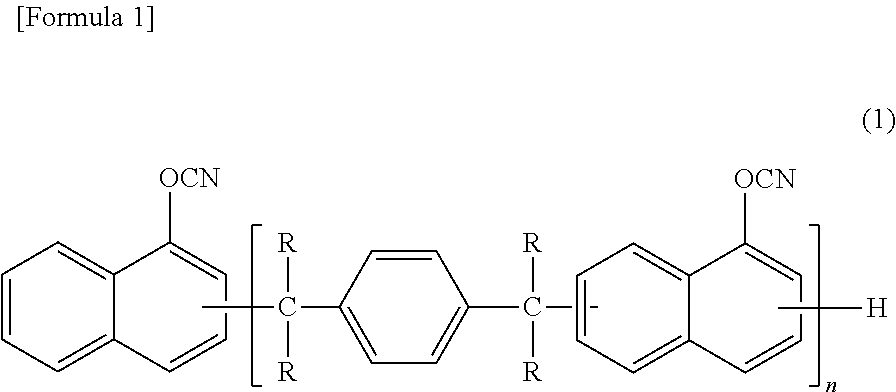Resin composition, prepreg and laminate
a technology which is applied in the field of resin composition and prepreg, and can solve the problems of resin and inorganic filler deterioration, cracks and voids, and printed wiring boards are highly filled with inorganic filler, and achieve good moldability, good reproducibility, and excellent heat dissipation properties
- Summary
- Abstract
- Description
- Claims
- Application Information
AI Technical Summary
Benefits of technology
Problems solved by technology
Method used
Image
Examples
synthesis example 1
[0064]0.47 moles (in terms of OH groups) of an α-naphthol aralkyl resin (SN495V, OH group equivalent: 236 g / eq., manufactured by Nippon Steel Chemical Co., Ltd.: including those in which the number of repeating units n of naphthol aralkyl was 1 to 5) was dissolved in 500 ml of chloroform in a reactor, and 0.7 moles of triethylamine was added to this solution. While the temperature was maintained at −10° C., 300 g of a chloroform solution of 0.93 moles of cyanogen chloride was dropped into the reactor over 1.5 hours. After the completion of the dropping, the mixture was stirred for 30 minutes. Then, a mixed solution of 0.1 moles of triethylamine and 30 g of chloroform was further dropped into the reactor, and the mixture was stirred for 30 minutes to complete the reaction. Hydrochloride of triethylamine produced as a by-product was filtered off from the reaction liquid. Then, the obtained filtrate was washed with 500 ml of 0.1 N hydrochloric acid, and then repeatedly washed with 500 ...
example 1
[0065]Forty parts by mass of the α-naphthol aralkyl-based cyanate ester compound obtained in Synthesis Example 1, 20 parts by mass of bis(3-ethyl-5-methyl-4-maleimidephenyl)methane (BMI-70, manufactured by K.I Chemical Industry Co., Ltd.), 40 parts by mass of a biphenyl aralkyl-based epoxy resin (NC-3000-FH, manufactured by Nippon Kayaku Co., Ltd.), 5 parts by mass of a silane coupling agent (Z6040, manufactured by Dow Corning Toray Co., Ltd.), and 5 parts by mass of a wetting and dispersing agent comprising an acid group (BYK-W903, manufactured by BYK Japan KK) were dissolved and mixed in methyl ethyl ketone, and 240 parts by mass of boehmite having an average particle diameter of 3 μm (BMT33W, manufactured by KAWAI LIME INDUSTRY CO., LTD.), 60 parts by mass of spherical alumina having an average particle diameter of 0.3 μm (ASFP-20, manufactured by DENKI KAGAKU KOGYO KABUSHIKI KAISHA), 3 parts by mass of zinc molybdate (manufactured by NIPPON INORGANIC COLOUR & CHEMICAL CO., LTD.)...
example 2
[0074]Operation was performed as in Example 1 except that the amount of the α-naphthol aralkyl-based cyanate ester compound blended was changed to 30 parts by mass, 30 parts by mass of a maleimide compound (BMI-2300, manufactured by Daiwa Kasei Co., Ltd.) was used instead of the bis(3-ethyl-5-methyl-4-maleimidephenyl)methane, and 40 parts by mass of a polyoxynaphthylene-based epoxy resin (HP6000, manufactured by DIC) was used instead of the biphenyl aralkyl-based epoxy resin. The various physical property values of the obtained metal foil-clad laminates are shown in Table 1.
PUM
| Property | Measurement | Unit |
|---|---|---|
| particle diameter | aaaaa | aaaaa |
| volume ratio | aaaaa | aaaaa |
| particle diameter | aaaaa | aaaaa |
Abstract
Description
Claims
Application Information
 Login to View More
Login to View More - R&D
- Intellectual Property
- Life Sciences
- Materials
- Tech Scout
- Unparalleled Data Quality
- Higher Quality Content
- 60% Fewer Hallucinations
Browse by: Latest US Patents, China's latest patents, Technical Efficacy Thesaurus, Application Domain, Technology Topic, Popular Technical Reports.
© 2025 PatSnap. All rights reserved.Legal|Privacy policy|Modern Slavery Act Transparency Statement|Sitemap|About US| Contact US: help@patsnap.com



